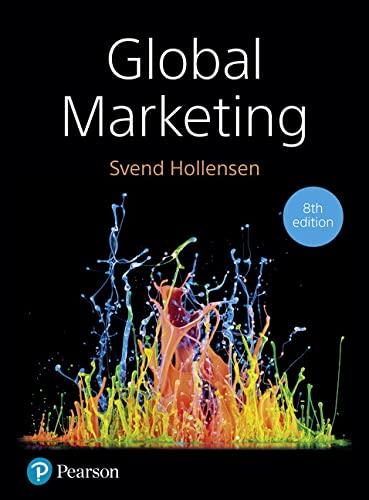Polo Ralph Lauren Corporation, founded in 1967 by Ralph Lauren, is a leader in the design, marketing
Question:
Polo Ralph Lauren Corporation, founded in 1967 by Ralph Lauren, is a leader in the design, marketing and distribution of premium lifestyle products, including men’s, women’s and children’s apparel, accessories, fragrances and home furnishings.
The Polo Ralph Lauren is an iconic American brand, which has always been synonymous with American heritage and lifestyle, excellent craftsmanship and classic design. Maintaining the balance between the classics and the latest trends is the brand’s core element. This has also attracted consumers from different age groups. ‘Polo’ got into the brand and company name, because Ralph Lauren wanted to pay tribute to his love of sports.
The basis of this case is 2009, where the total net revenue was US$5 billion and net profits were US$595 million.
Polo Ralph Lauren operated in three distinct but integrated segments:
1. Wholesale. The wholesale business (representing approximately 57 per cent of 2009 net revenues)
consisted of wholesale-channel sales made principally to major department stores, speciality stores and golf and pro shops located throughout the US, Europe and Asia.
2. Retail. The retail business (representing approximately 39 per cent of 2009 net revenues) consisted of retail-channel sales directly to consumers through full-price and factory retail stores located throughout the US, Canada, Europe, South America and Asia, and through the retail internet sites located at www.RalphLauren.com and www.
Rugby.com.
3. Licensing. Licensing business (representing approximately 4 per cent of 2009 net revenues)
consists of royalty-based arrangements under which they license the right to third parties to use the various trademarks in connection with the manufacture and sale of designated products, such as apparel, eyewear and fragrances, in specified geographical areas for specified periods.
RalphLauren.com offers the customers online access to the full breadth of Ralph Lauren apparel, accessories and home products, allows them to reach retail customers on a multichannel basis and reinforces the luxury image of the brands.
In August 2008, the company launched Rugby.
com, its second e-commerce website. Rugby.com offers clothing and accessories for purchase – previously only available at Rugby stores – along with style tips, unique videos and blog-based content.
Rugby.com offers an extensive array of Rugby products for young men and women.
The business is typically affected by seasonal trends, with higher levels of sales resulting primarily from key vacation travel, back-to-school and holiday shopping periods (e.g. Christmas) in the retail segment.
Since 1967, the distinctive brand image has been consistently developed across an expanding number of products, price tiers and markets. Reflecting a distinctive American lifestyle under the direction of internationally renowned designer Ralph Lauren, they have a considerable influence on the way people dress and the way that fashion is advertised throughout the world.
In 2009 the company’s product portfolio consisted of four product lines:
1. Apparel: products include extensive collections of men’s, women’s and children’s clothing.
2. Accessories: products encompass a broad range, including footwear, eyewear, watches, jewellery, hats, belts and leather goods, including handbags and luggage.
3. Home: coordinated products for the home include bedding and bath products, furniture, fabric and wallpaper, paint, tabletop and giftware.
4. Fragrance: fragrance products are sold under Romance, Polo, Lauren, Safari, Ralph and Black Label brands, among others.
Use of licensing in far distance markets In the beginning of 2009, Polo Ralph Lauren granted a licence for the right to sell at wholesale specified categories of products in far distance markets. These geographic area licensed source products from product licensing partners and independent sources.
Each licensing partner paid Polo Ralph Lauren royalties based upon its sales of their products, generally subject to a minimum royalty requirement for the right to use the company’s trademarks and design services. In addition, licensing partners were required to allocate a portion of their revenues to advertise the products and share in the creative costs associated with these products. Larger allocations were required in connection with launches of new products or in new territories. The licences generally had three-to five-year terms and granted the licensee conditional renewal options.
Polo Ralph Lauren worked closely with its licensing partners to ensure that its products were developed, marketed and distributed so as to reach the intended market opportunity and to present consistently the distinctive perspective to consumers worldwide and also present the lifestyle associated with its brands. Many aspects of the packaging, merchandising, distribution, advertising and promotion of the products were subject to continuing oversight by Polo Ralph Lauren. The result was a consistent identity for Ralph Lauren products across product categories and international markets.
At the beginning of 2009 Polo Ralph Lauren had four licensing partners, covering the following geographical areas:
1. Oroton Group/PRL Australia: Australia and New Zealand
2. Doosan Corporation: Korea
3. P.R.L. Enterprises, S.A.: Panama, Aruba, Curacao, The Cayman Islands, Costa Rica, Nicaragua, Honduras, El Salvador, Guatemala, Belize, Colombia, Ecuador, Bolivia, Peru, Antigua, Barbados, Bonaire, Dominican Republic, St Lucia, St Martin, Trinidad and Tobago
4. Dickson Concepts: Hong Kong, China, the Philippines, Malaysia, Singapore, Taiwan, Thailand and Indonesia Typically, the international licensing partners acquired the right to sell, promote, market and/or distribute various categories of the Polo Ralph Lauren products in a given geographic area......
Questions
1. What are the likely main motives for Polo Ralph Lauren to shift the entry mode from licensing to the hierarchical mode in South-east Asia?
2. Would you recommend they take all geographical licences back in-house and turn them into hierarchical modes? If not, why?
Step by Step Answer:






